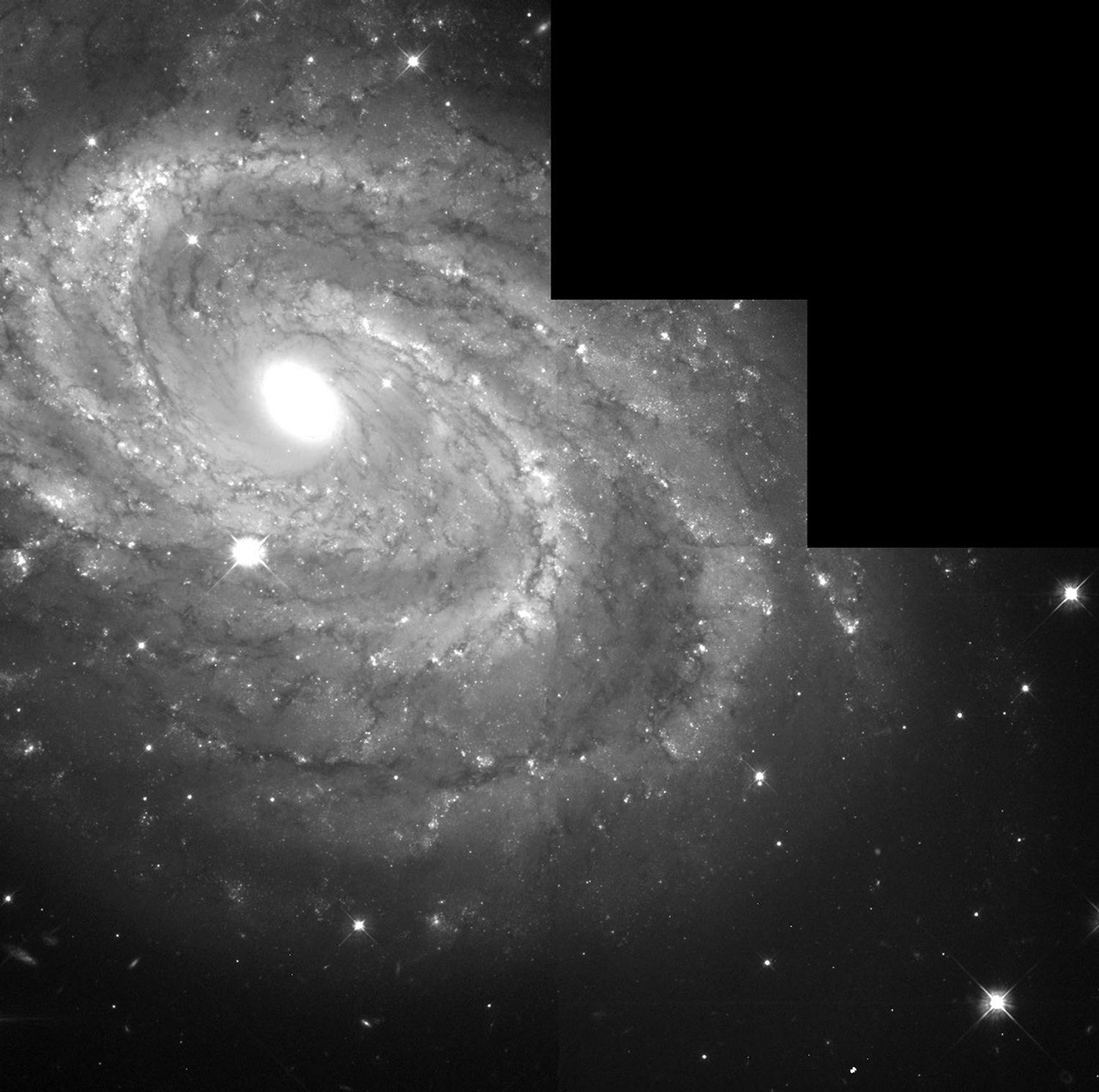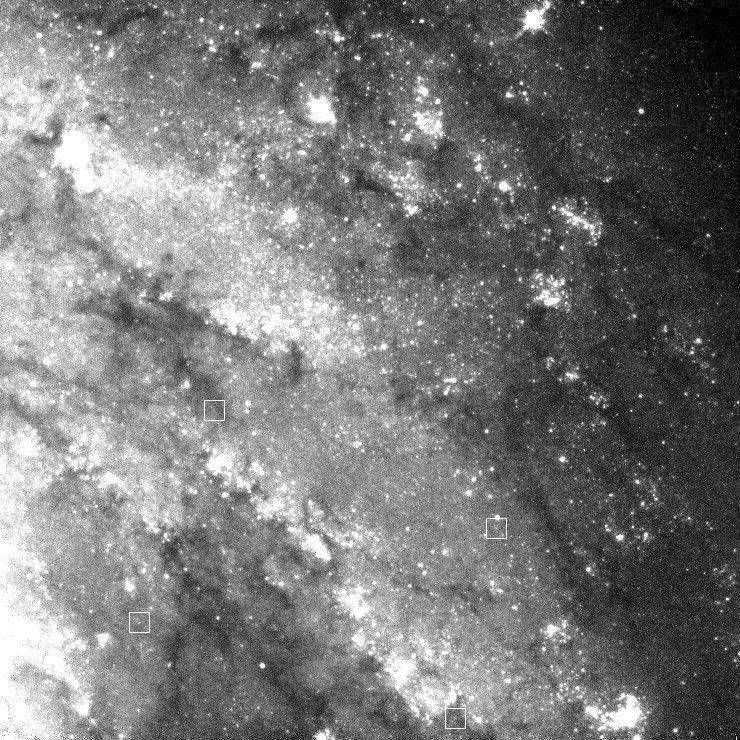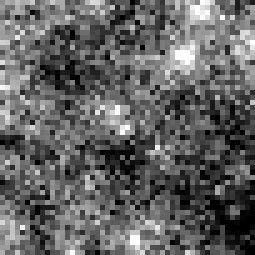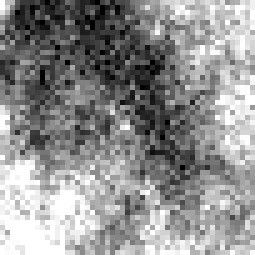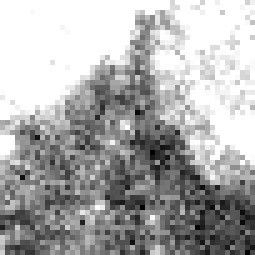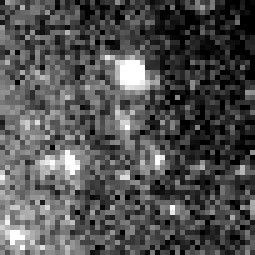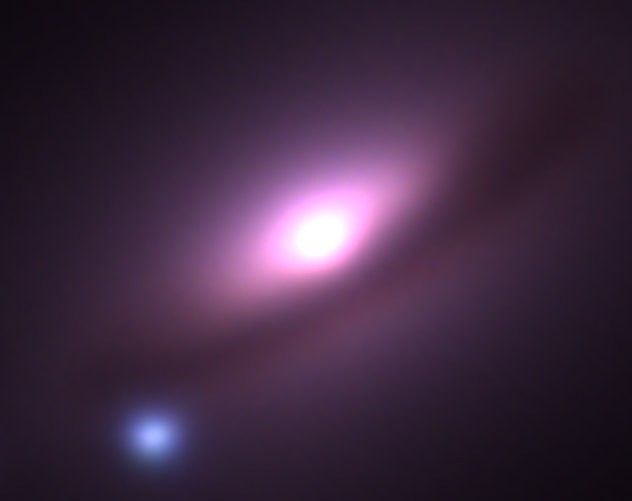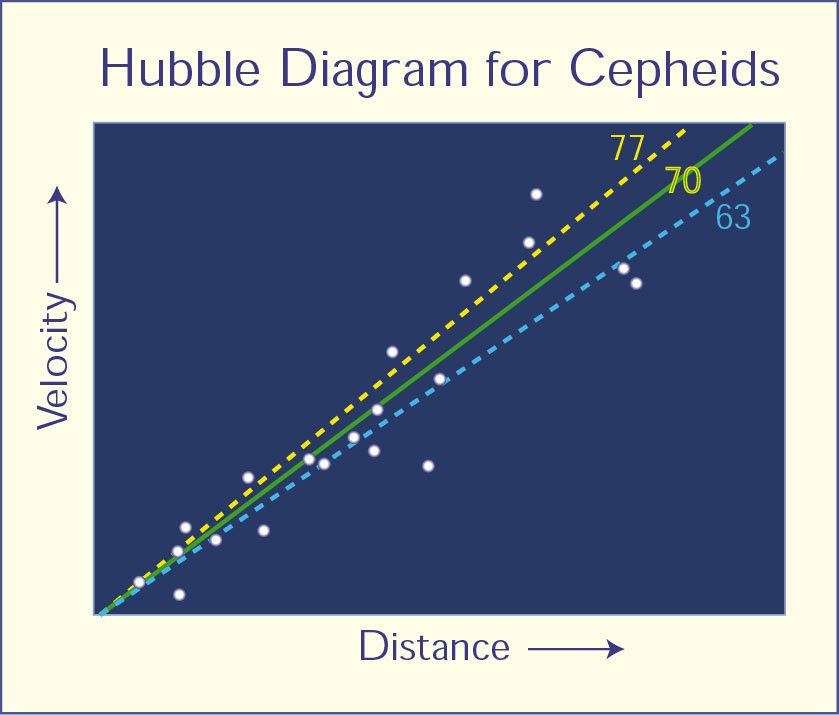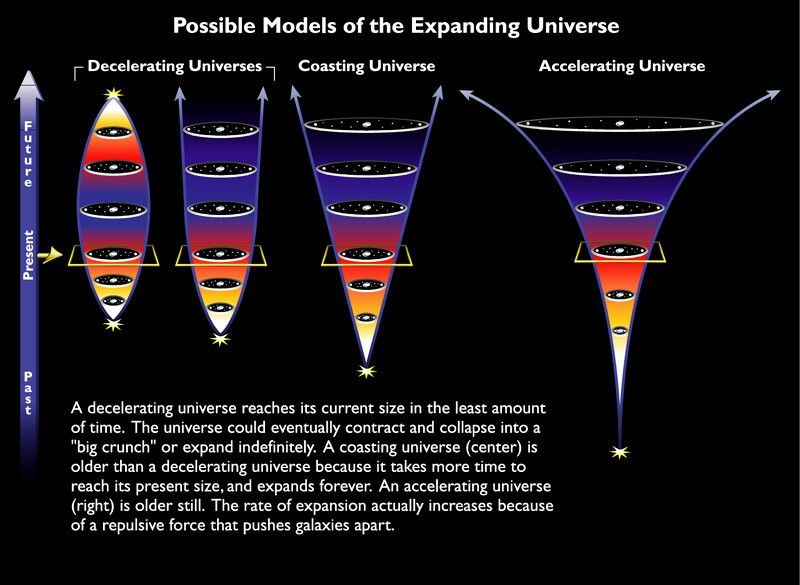The Hubble Space Telescope Key Project team today announced that it has completed efforts to measure precise distances to far-flung galaxies, an essential ingredient needed to determine the age, size and fate of the universe.
"Before Hubble, astronomers could not decide if the universe was 10 billion or 20 billion years old. The size scale of the universe had a range so vast that it didn't allow astronomers to confront with any certainty many of the most basic questions about the origin and eventual fate of the cosmos," said team leader Wendy Freedman, of the Observatories of the Carnegie Institution of Washington. "After all these years, we are finally entering an era of precision cosmology. Now we can more reliably address the broader picture of the universe's origin, evolution and destiny."
The team's precise measurements are the key to learning about the expansion rate of the universe, called the Hubble constant. Measuring the Hubble constant was one of the three major goals for NASA's Hubble Space Telescope before it was launched in 1990.
For the past 70 years astronomers have sought a precise measurement of the Hubble constant, ever since astronomer Edwin Hubble realized that galaxies were rushing away from each other at a rate proportional to their distance, i.e. the farther away, the faster the recession. For many years, right up until the launch of the Hubble telescope - the range of measured values for the expansion rate was from 50 to 100 kilometers per second per megaparsec (a megaparsec, or mpc, is 3.26 million light-years).
The team measured the Hubble constant at 70 km/sec/mpc, with an uncertainty of 10 percent. This means that a galaxy appears to be moving 160 thousand miles per hour faster for every 3.3 million light-years away from Earth.
"The truth is out there, and we will find it," said Dr. Robert Kirshner, of Harvard University. "We used to disagree by a factor of 2; now we are just as passionate about 10 percent. A factor of two is like being unsure if you have one foot or two. Ten percent is like arguing about one toe. It's a big step forward."
Adds Dr. Robert Kennicutt of the University of Arizona, a co-leader of the team: "Things are beginning to add up. The factor of two controversy is over."
The team used the Hubble telescope to observe 18 galaxies out to 65 million light-years. They discovered almost 800 Cepheid variable stars, a special class of pulsating star used for accurate distance measurement. Although Cepheids are rare, they provide a very reliable "standard candle" for estimating intergalactic distances. The team used the stars to calibrate many different methods for measuring distances.
"Our results are a legacy from Hubble telescope that will be used in a variety of future research," said Dr. Jeremy Mould, of the Australian National University, also a co-leader of the team. "It's exciting to see the different methods of measuring galaxy distances converge, calibrated by the Hubble Space Telescope."
Combining the Hubble constant measurement with estimates for the density of the universe, the team determined that the universe is approximately 12 billion years old - similar to the oldest stars. This discovery clears up a nagging paradox that arose from previous age estimates. The researchers emphasize that the age estimate holds true if the universe is below the so-called "critical density" where it is delicately balanced between expanding forever or collapsing. Or, the universe is pervaded by a mysterious force pushing the galaxies farther apart, in which case the Hubble measurements point to an even older universe.
The universe's age is calculated using the expansion rate from precise distance measurements, and the calculated age is refined based on whether the universe appears to be accelerating or decelerating, given the amount of matter observed in space. A rapid expansion rate indicates the universe did not require as much time to reach its present size, and so it is younger than if it were expanding more slowly.
The Hubble Space Telescope Key Project team is an international group of 27 astronomers from 13 different U.S. and international institutions. The Space Telescope Science Institute is operated by the Association of Universities for Research in Astronomy, Inc. for NASA, under contract with NASA's Goddard Space Flight Center in Greenbelt, MD.
BACKGROUND INFORMATION: BUILDING A LADDER TO THE STARS – THE 90-YEAR QUEST FOR THE SIZE OF THE UNIVERSE
Albert Einstein rejected it, Edwin Hubble embraced it, and many astronomers since then have debated it. Now a team of astronomers using the Earth-orbiting Hubble Space Telescope, named after Edwin, has refined the value for the expansion rate of the cosmos, called the Hubble constant. This number holds the key to other fundamental astronomical questions. By nailing down the Hubble constant, astronomers can figure out the size of the universe and work backward to determine how long it has been around. Here is a thumbnail history of the Hubble constant.
1908: Harvard Observatory astronomer Henrietta S. Leavitt makes the first crucial step in establishing the distances to nearby "spiral nebulae." Studying variable stars in the Magellanic Clouds, she discovers the presence of rhythmically pulsating stars, known as Cepheid variables, which brighten and dim over a period of days. By observing the relationship between a Cepheid's brightness and its pulsation rate, astronomers can calculate how much light it emits and then use that number to estimate its distance.
1912: Vesto M. Slipher of Lowell Observatory studies the motion of about 50 "spiral nebulae." He notices that most of them appear to be fleeing away from Earth at a very fast rate.
1916-1927: Einstein applies his newly published general theory of relativity to the structure of the universe. In Einstein's universe, space remains static, neither expanding nor contracting. Willem de Sitter counters in 1917 with an expanding universe model, also consistent with Einstein's theory. De Sitter's universe, however, is devoid of matter. Aleksandr Friedmann and Georges Lemaitre also join the theoretical jousting match, providing their own models for an expanding universe.
1923: Edwin Hubble, working at the Carnegie Institution's Mount Wilson Observatory in California, pinpoints 12 Cepheid variable stars in the "spiral nebulae" M31 and M33. By deducing the distances, he establishes that they are individual galaxies, far outside the Milky Way galaxy.
1929: Hubble delivers the observational evidence that space is expanding. Studying 18 spiral galaxies, Hubble discovers a connection between the motions of galaxies and their distances from our galaxy. He proposes that the farther a galaxy is from us, the faster it is speeding into space. For example, a galaxy 10 times farther away than another would be moving 10 times faster. He calls this relationship the "velocity-distance relation." Today astronomers call it Hubble's law, and the value that relates the velocity to the distance is called the Hubble constant.
1931: Hubble and Milton L. Humason determine the brightness of Cepheid variable stars in the Local Group of galaxies and other stars in M81, M101, and NGC 2403. They calculate a Hubble constant of 558 kilometers per second per megaparsec. In other words, galaxies appear to be receding from us at a rate of 383,000 mph for every one million light-years farther out we look.
1954: The Hubble constant tumbles from 558 to 280 when Walter Baade shows that Hubble had unknowingly used two distinct populations of stars – with different relationships between pulsation rate and light output – to calibrate distance. He had therefore underestimated the distances to nearby galaxies and hence the size of the universe.
1956: After Hubble's death, Allan Sandage of the Carnegie Observatories in Pasadena, Calif., takes up the quest for the Hubble constant. He discovers that many of the objects Hubble had regarded as the brightest stars in nearby galaxies are in fact groups of stars or clouds of illuminated gas. Sandage slashes the Hubble constant to 75, further increasing the distance scale. A lower Hubble constant implies that the universe is expanding slowly and that it has taken a longer time to reach its current size.
1956-1994: Over the next four decades, several astronomers pursue the Hubble constant, most notably Sandage, Gustav Tammann of the University of Basel in Switzerland, Gerard de Vaucouleurs of the University of Texas, and Sidney van den Bergh of Dominion Astrophysical Observatories in Canada. Sandage and Tammann chip away at the number, arriving at a value of around 50. De Vaucouleurs and van den Bergh, Sandage's primary sparring partners, reach values around 100. A number of younger astronomers, among them Brent Tully, Richard Fisher, Marc Aaronson, Jeremy Mould, John Huchra, Rob Kennicutt, Barry Madore, and Wendy Freedman, enter the field and begin to derive values between 50 and 100.
Astronomers realize that they have hit a cosmological brick wall. Ground-based telescopes can only resolve Cepheid variables, the cosmological "milepost markers," in nearby galaxies. To obtain an accurate value for the Hubble constant, astronomers recognize that they must peer farther across space. One of the mandates for the Earth-orbiting Hubble Space Telescope – launched in 1990 – is to catch the pulsating rhythms of Cepheids at greater distances. The telescope is expected to collect Cepheids in galaxies 10 times farther away than ground-based telescopes can spot them.
1994: Wendy Freedman of the Carnegie Observatories in Pasadena, Calif., Jeremy Mould of the Australian National University, Robert Kennicutt of the University of Arizona in Tucson, and an international team of astronomers announce that the Hubble telescope had "pushed the envelope," detecting Cepheid variable stars farther out in space than ever before. The telescope had spied these "milepost markers" in the remote spiral galaxy M100, a member of the Virgo cluster. This preliminary observation establishes the distance to the cluster as about 56 million light-years and a Hubble constant of 80.
1994-1999: While Cepheid variables are useful "cosmic yardsticks," even the Hubble telescope can't pick them out of far-flung galaxies. So, the Freedman, Mould, and Kennicutt team refines a technique dubbed the "cosmological distance ladder" to gauge distances to galaxies far across the cosmos. The team uses Cepheids from nearby galaxies and "secondary distance markers" – such as a special class of exploding star called Type Ia supernovae – to determine distances to faraway galaxies. In 1996 a separate team led by Sandage reports a value of 57, and subsequently a value of 59.
1999: The Freedman, Mould, and Kennicutt team announces its final measurement for the universe's expansion rate. The astronomers determine a value of 70, with an uncertainty of 10 percent. Using the Hubble telescope to observe 18 galaxies – the farthest of which is 65 million light-years away – they discover about 800 Cepheids. These predictable stars are then used to measure even farther distances with the "secondary distance markers."


























